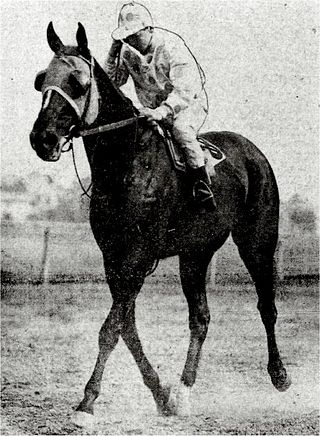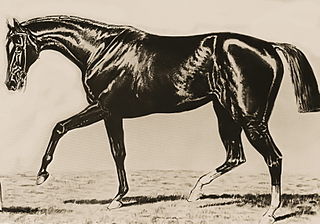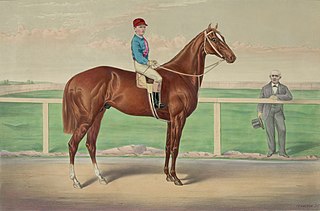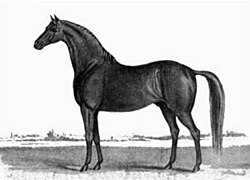
The Byerley Turk, also spelled Byerly Turk, was the earliest of three stallions that were the founders of the modern Thoroughbred horse racing bloodstock.

The Godolphin Arabian, also known as the Godolphin Barb, was an Arabian horse who was one of three stallions that founded the modern Thoroughbred. He was named after his best-known owner, Francis Godolphin, 2nd Earl of Godolphin.
Gem Twist was a 16.3 hands world champion American Thoroughbred show jumping horse registered under the name Icey Twist. Bred by equestrian Frank Chapot, Gem Twist had an incredible career at the Grand Prix level. The gelding is the only horse to have won the "American Grand Prix Association Horse of the Year" title three times, and is regarded as one of the best show-jumpers in history.

Lexington was a United States Thoroughbred race horse who won six of his seven race starts. Perhaps his greatest fame, however, came as the most successful sire of the second half of the nineteenth century; he was the leading sire in North America 16 times, and broodmare sire of many notable racehorses.

Boston (1833–1850) was an outstanding Thoroughbred racehorse and a leading sire in North America three times from 1851 to 1853. He started in about 45 races, winning 40, including 15 in succession. Boston was later one of the initial inductees into the Hall of Fame.

Diomed (1777–1808) was an English Thoroughbred race horse who won the inaugural running of the Epsom Derby in 1780. Sold and imported to Virginia, he was subsequently a successful sire in the United States after the American Revolutionary War.

Kingston (1884–1912) was an American Thoroughbred racehorse. He won 89 races, the most in the history of the sport of thoroughbred racing. Of his 138 starts, he was out of the money only on four occasions. He was later inducted into the United States Racing Hall of Fame.

Peter Pan (1904–1933) was an American Thoroughbred racehorse and sire, bred and raced by prominent horseman, James R. Keene. As winner of the Belmont Stakes, the Brooklyn Derby and the Brighton Handicap, he was later inducted into the National Museum of Racing and Hall of Fame. His progeny included many famous American racehorses, including several winners of the Kentucky Derby and the Preakness Stakes.

Cade (1734–1756) was an important foundation sire of Thoroughbred racehorses. He was the Leading sire in Great Britain and Ireland in 1752, 1753, 1758, 1759 and 1760.

Herod was a Thoroughbred racehorse. He was one of the three foundation sires of the modern Thoroughbred racehorse, along with Matchem and Eclipse. Herod was the foundation sire responsible for keeping the Byerley Turk sire-line alive.

Highflyer was an undefeated Thoroughbred racehorse and a very successful sire of the 18th century.
Florizel (1768–1791) was a British Thoroughbred racehorse. He was a bay son of Herod foaled in 1768.

Spendthrift was a successful American Thoroughbred racehorse and an outstanding sire.

Sir Archy was an American Thoroughbred racehorse considered one of the best racehorses of his time and later one of the most important sires in American history. He was inducted into the National Museum of Racing and Hall of Fame in the inaugural class of 1955.
Emperor of Norfolk (1885–1907) was an American Champion and Hall of Fame Thoroughbred racehorse. His large size, strong hindquarters, and racing record earned him the name of the "California Wonder".
Lady Lightfoot, was an American Thoroughbred racing mare.

Kentucky (1861–1875), was a successful American Thoroughbred racehorse who won 21 of his 23 starts, including 20 consecutive wins.

Harry Bassett (1868–1878) was an American Thoroughbred racehorse, winner of the 1871 Belmont Stakes and an outstanding racehorse of the 19th century. He also won a number of other stakes races, and was named the Champion male of his age group in 1870, 1871 and 1872. He was retired to stud duties in New Jersey when his five-year racing career ended, having recorded 23 wins from 36 starts. Harry Bassett died in New Jersey in 1878 and was inducted into the United States Racing Hall of Fame in 2010.
Saltram (1780–1802) was a British Thoroughbred racehorse and sire. In a career that lasted from spring 1783 to May 1785 he ran eight times and won four races. In 1783 he won the fourth running of The Derby on his third racecourse appearance. He won one race in 1784 and was then sold to George, Prince of Wales for whom he won a race at Newmarket in 1785 before being retired to stud. After having some success as a stallion in England he was exported to the United States where he died in 1802.
Sir Charles was an American Thoroughbred racehorse and an important sire in the early development of the breed in North America. In 1830, he became the first horse to earn the title of Leading sire in North America, followed by wins in 1831, 1832, 1833 and 1836.
(*Australian Stud Book says 1814. Bloodlines says 1813.)














